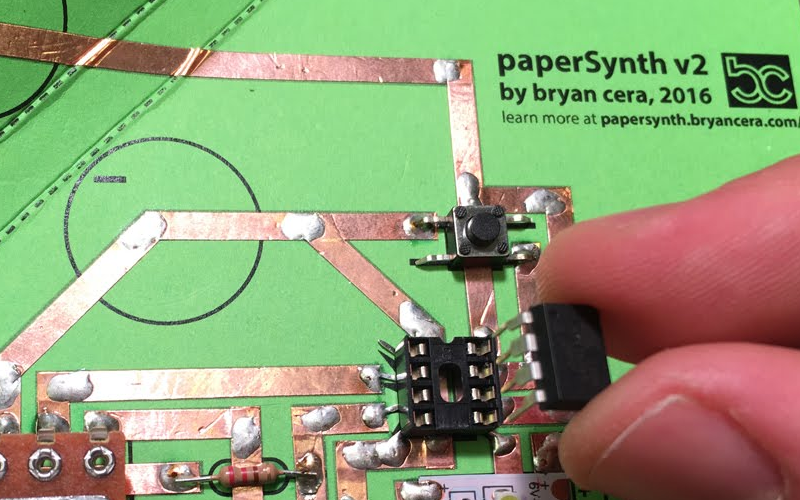Craft stores are often the source of odd inspiration. In the stained glass section, we’ve seen the copper foil, and even used it to prototype some RF circuits on the tops of shoeboxes. However, we could never get a good method for connecting ICs to the relatively thick foil. [Bryan Cera] did it though. His paperSynth uses some paper and cardboard for a substrate, copper foil, and an ATtiny CPU to make music. You can see the device in operation in the video, below.
The copper foil is sticky and it isn’t conductive on the back, so anywhere the foil is supposed to touch, you need a blob of solder. We wouldn’t trust the insulation by itself to cross wires, but with a bit of insulating material between–a piece of paper or electrical tape, for example–you could probably cross with impunity. For an RF circuit, you might even make low-value capacitors like that.
Even though we’ve used foil before, we got a lot out of reading this project. The battery clip and on/off switch was ingenious. There are five different modes for the synthesizer. Single notes, double notes, triads, four notes, and a drum mode.
If you want something more sonically impressive, like this Teensy-based poly synthesizer we looked at recently, you might have to change to a different construction technique. For a quick project, using copper tape and cardboard can get you going fast and still have a neat appearance. We like it. If you think tape is low tech, by the way, think again.















why?
why not?
I think it would make a neat kit for kids if you removed the soldering and used conductive epoxy
>”if you removed the soldering”
Why?
It depends a little on age of the kids. But if it’s somehow adequate I would go with soldering even for kids. With conductive glue you have to wait between most of the joints until the stuff sets, this can get very boring.
I taught my daughter to solder at 6. There wasn’t much to it. She understood that if she wasn’t careful, she’d be…unhappy. We started with kits like http://lowvoltagelabs.com/products/ghost-kit/. She picked it right up and had fun doing it
I wonder if he’d get better volume out of it if he turned the speaker over? So it coupled with the paper to resonate…?
That looks like a headphone element. It sounds like one too, not a loudspeaker. This video has the lowest volume ever. Even after I turned the radio off I couldn’t hear anything.
Sounds good to me. But I wonder how flexible that foil is? Attach to a flexible plastic substrate.
Pretty flexible. I used it to enhance a shock mat to keep the dogs out of the kitchen. It holds up to being walked on, crumpled up, rolled up
I’ve been looking for a synth to make for my kid and I think this one is it! It’s great!
I love this method. I have suspected that other substrates would be great for making circuits with, card stock is a great one, I think plywood veneers could be used as well. Tape the circuit, then laminate the veneers, you have a wood circuit!
I’m surprised I haven’t seen a “hack” that uses something like thin copper sheets to make stick-down circuits using a relatively cheap Vynil craft cutter device – especially when it comes to minimalist RF circuits (e.g. simple spiral inductors to make a Class-D RF amplifier/transmitter).
Cool project :) Congrats on making it work!
This is a great idea.